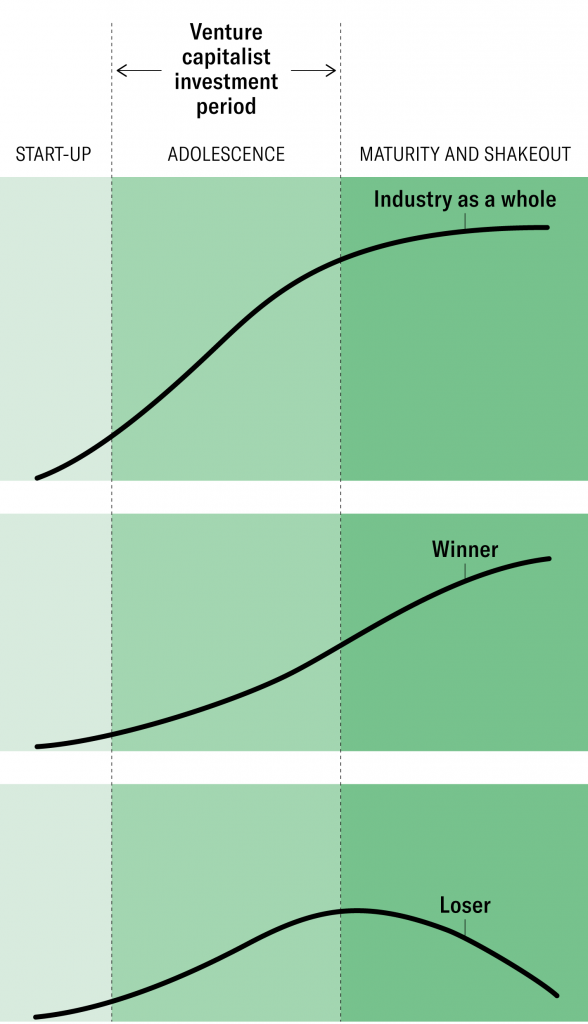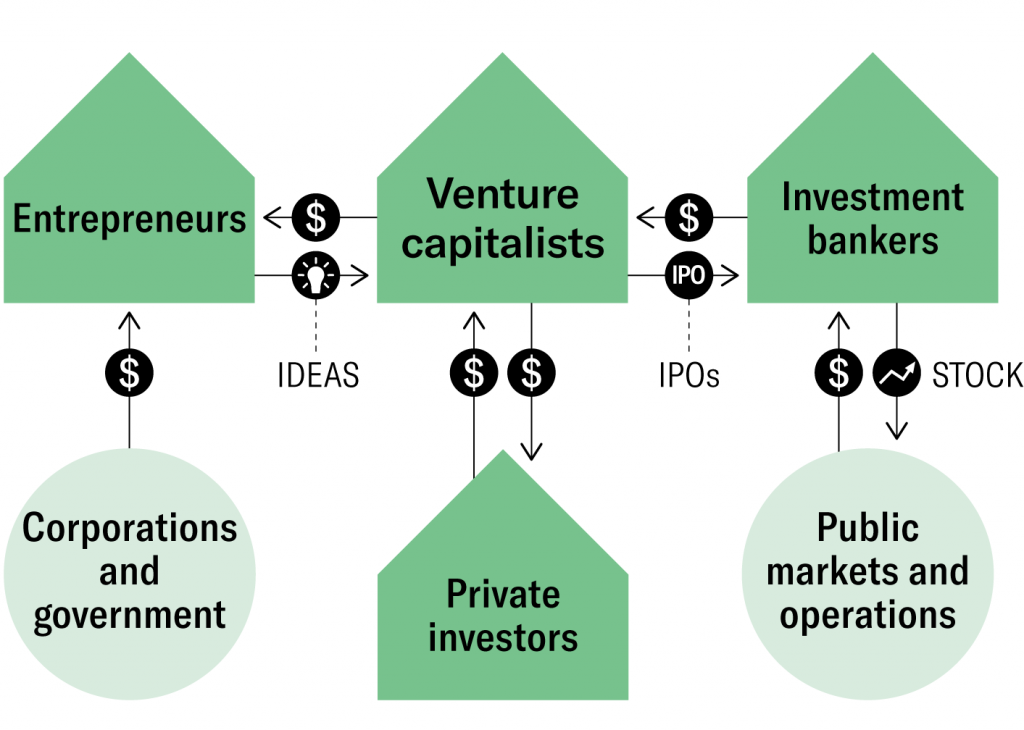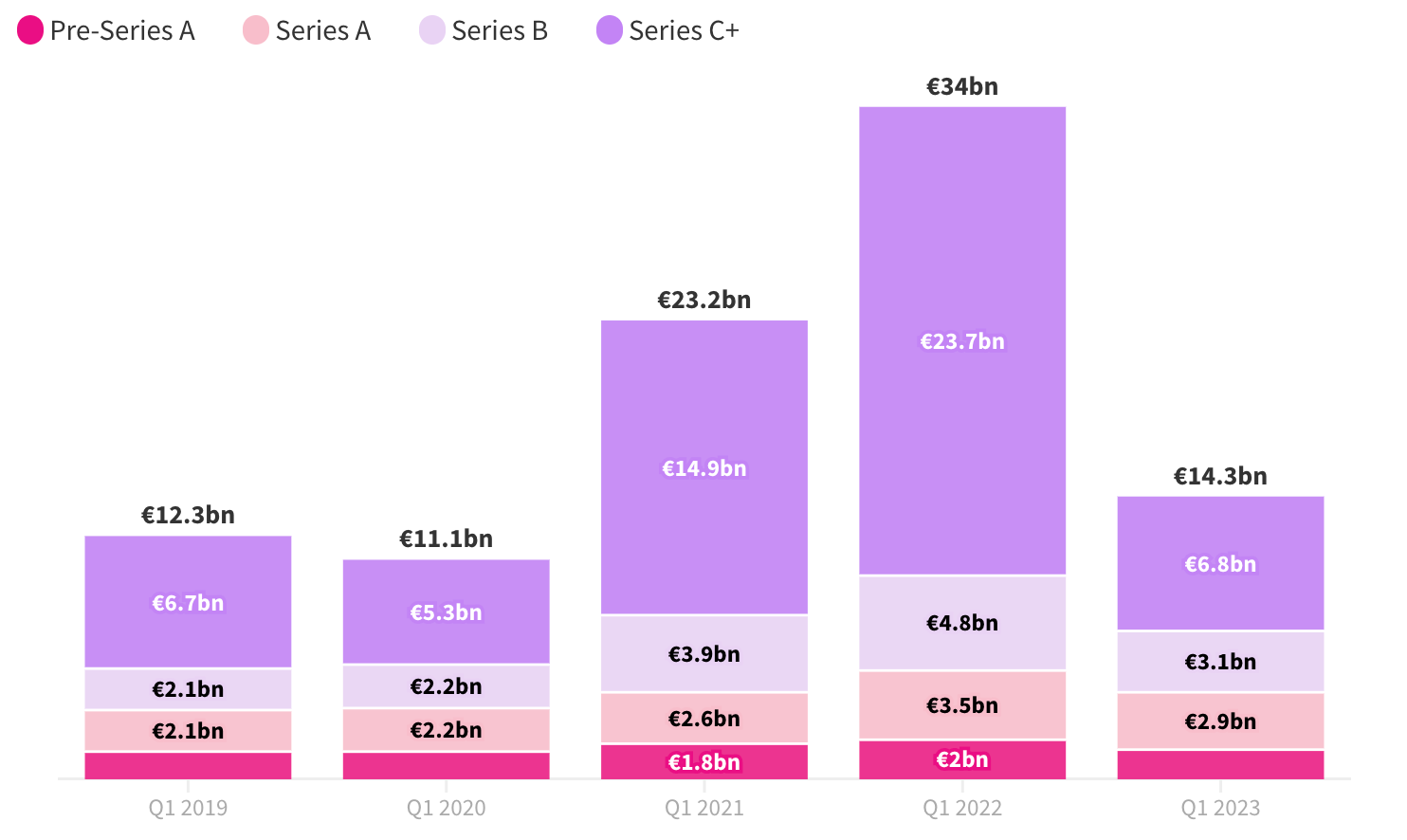Welcome,
Decoding a Secret:
Venture Capital vs Rising Interest Rates
My dear Friends,
I understand the apprehension that comes with the idea of investing. Whether you’ve diligently accumulated your wealth, inherited it, or undergone a significant divorce settlement, the notion can be daunting.
The media often portrays a gloomy picture, highlighting the challenges start-ups and innovations face due to a recent decline in Venture Capital funding. It seems rising interest rates are again the main culprit.
For women new to the venture capital world, decoding the connection between Venture Capital funding and rising interest rates might just be an eye-opener for new possibilities. So, let’s embark on this intriguing journey through the realm of venture capital and rising interest rates.
Together we decode the nuances, decipher the patterns, and gain a deeper understanding of how the forces of high-interest rates shape the investment landscape.
Fueling Startup Dreams
Invention and innovation are the main drives of the economy. Venture Capital is certainly an exhilarating world. This is where big dreams are brought to life through strategic investments. Venture capital is a dynamic realm that presents both thrilling opportunities and unique challenges for investors.
It’s a realm where dreams meet reality, innovation is nurtured, and fortunes are made. Without a doubt, Venture Capital is a captivating domain that fuels the growth of startups while offering aspiring investors a chance to ride the wave of success.
Venture capital is the fuel that propels ambitious entrepreneurs and their groundbreaking ideas forward. It’s a realm where innovation meets capital, and dreams transform into reality. Venture capitalists have the extraordinary opportunity to support early-stage companies and be part of their growth story. Just picture yourself as a catalyst, providing the necessary resources and expertise to turn a visionary concept into a successful venture.
Understanding the game
Invention and innovation are the main drives of the economy. We have all heard about the against-all-odds success stories of Silicon Valley entrepreneurs. Stories about an idea that came to fruition in a garage(Steve Jobs) as well as the big cheats like Theranos(Elizabeth Holmes) or FTX (Sam Bankman Fried) – two con artists who extracted enormous sums from well-meaning and naive investors who believed they were funding a groundbreaking idea.
Rest assured, I am sure there is a start-up scene near you as innovative as Silicon Valley. The start-up ecosystem spans from Silicon Valley to New Delhi and from Seoul to London, as much as from Tel Aviv to Berlin and Sao Paulo.
The US start-up scene is the most active and successful in the world, despite its occasional hiccups. However, it should be mentioned that the collective imagination- startups and investors alike- tends to romanticise the US market a bit. Start-ups from Berlin to Seoul dream about cash-rich US investors and the US‘s super relaxed regulations.
Filling a void
Well, ideas need money to come to fruition. Enter the Venture Capitalist, a trail-wise, know-all piggybank. Ready to help the innovator through the many tight spots along the way to fame.
However, that service does not come for free – this knight or lady in shining armour takes quite a chunk of the cake once it’s fully baked.
Contrary to common belief, venture capital funds only a few early-stage businesses (seed stage). Venture capital, however, becomes particularly relevant when it comes to the growth phase of the innovation journey—when companies are ready to bring their innovations to the market.
During this crucial period, venture capitalists provide vital funding for companies to build the necessary infrastructure, such as manufacturing capabilities, marketing efforts, and sales operations.
In fact, more than 80% of venture capital investments are directed towards supporting the growth and expansion of these businesses.
A lucrative niche
Venture capital has carved out its own unique space in the financial world, driven by the structure and rules of capital markets. It serves as a lifeline for individuals with groundbreaking ideas or new technologies who have limited options elsewhere. Banks face restrictions on interest rates they can charge due to usury laws.
Since start-ups inherently carry more risk, this would require banks to charge a higher interest rate on loans than they are allowed to. Banks typically lend money based on tangible assets that can serve as collateral, leaving many information-based start-ups with limited access to traditional funding.
Adding to the challenge, investment banks and public equity face regulations and operating practices designed to protect the public investor. Historically, companies needed substantial sales, assets, and a profitable track record to access the public market. These thresholds, which most companies don’t meet, create a financing barrier for entrepreneurs.
This is where venture capital steps in, bridging the gap between innovation sources like corporations, government bodies, friends, and family and the traditional, more affordable capital sources available to established businesses. To fill that void, Venture Capital needs to provide sufficient return on capital for private equity and enough stimulus for the entrepreneur to come up with high-quality ideas that will generate high returns.
In a nutshell, venture capital faces the challenge of consistently earning superior returns in inherently risky business ventures. It’s a dynamic world where investors seek out promising opportunities and strive to unlock their full potential. By investing in these ventures, venture capitalists aim to make a lasting impact while enjoying lucrative returns. It’s a thrilling and demanding pursuit that requires expertise, strategic thinking, and a knack for spotting exceptional opportunities in the ever-changing landscape of innovation.
The secret sauce
What attracts wealth owners or institutions to invest in venture capital funds? It’s not just about the specific investments themselves. Instead, they look at the firm’s overall track record, the fund’s captivating “story,” and their trust in the partners driving the venture forward. It’s all about confidence in the team and their ability to meet investors’ expectations while managing risk effectively.
But let’s dive deeper into the secret sauce of venture capital success—how they make the magic happen. Venture capitalists have a keen eye for promising industries that offer more forgiving competition than the broader market. Lately, the tech industry has been a hotspot for venture capital flows. As a general rule, venture capitalists focus on that sweet spot in the industry life cycle, avoiding the uncertain early stages and the later stages where fierce competition and slower growth prevail.

Venture capitalists allocate their capital where the action is, where most companies have a good shot at success in the near term. It’s not just about the individual entrepreneurs’ talent or charisma—it’s about being in the right place at the right time.
However, it can be challenging to distinguish the future winners from the losers. Financial performance and growth rates can look strikingly similar among these ambitious companies. That’s where the venture capitalist’s expertise comes into play. They search for competent management teams who can execute flawlessly, meeting the growing demand and delivering products to eager markets.
The players
Usually, entrepreneurs who are looking for capital submit business plans to a Venture Capital firm in the hope of obtaining funding. Suppose a Venture Capital firm considers a business plan to be promising. In that case, they dive deeper into the business model, product, management and operating history to assess the quality of the business and the idea.

When the due diligence process shines a positive light on the business idea, the VC firm extends its hand with a capital offer. In return, they become an equity partner, fueling the growth of the business. This partnership often spans multiple funding rounds, with the VC firm actively involved in guiding and supporting the portfolio company. It’s a dynamic collaboration that brings expertise and resources to propel your entrepreneurial journey forward.
The impact of rising interest rates
A recent publication of PREQUIN, a global analytics firm, claimed: ” Venture Capital funding has fallen off a cliff”. In fact, in Q4 2022, global Venture Capital investments dropped by 65%. Actually, the first drop in VC investments since 2009. Wonder why?
The trends driving the decline in VC funds are the same ones that impacted many tech companies last year. For one, fewer companies going public through IPOs, stocks and valuations are falling rapidly, and interest rates and inflation are rising.
The truth is Venture Capital funding was on a steep upward trajectory in 2021 and 2022 which could be considered a hype. Only to fall back to a more moderate and maybe healthier investing scenario.
VC Investments 2019 – 2023

Fewer IPOs
In response to lower demand by investment banks – fewer IPOs- VC firms are raising funds more slowly, so they have longer to raise the next one, thus reducing the fees they charge their investors and cutting back on their goals for fundraising.
Yet the intricate relationship between rising interest rates and venture capital also extends to exit strategies. Market conditions may become less favourable, making selling or taking a portfolio company public trickier. The stakes are high, and navigating this terrain requires strategic finesse.
Expensive Capital
This, in return, can impact the liquidity and profitability of venture capital investments.
Further, an important consideration for investors arises from the high-interest rates; capital is “more costly” to come by. Also, not forgetting the fact that by now, other financial market products, like the good old savings account, have nice yields, too. Contrary to the past ten years!
As a result, investors become more selective and are less likely to fund just any business idea with a charming CEO.
Investors recalibrate their expectations, seeking higher returns to offset the increased risks. This adjustment can profoundly impact the perceived value of companies seeking investment, potentially altering their funding prospects. As a result, the worth of businesses in the eyes of investors can shift, potentially impacting their ability to secure the funding they need to flourish.
As a result, startups and budding entrepreneurs face a more competitive environment, with fewer resources to fuel their dreams. It’s a game-changer that demands careful attention.
However, it is not all doom and gloom for the start-up industry. Within these challenges lies a realm of opportunities. Despite the hurdles, venture capital investments can still yield substantial returns. By understanding the intricacies of rising interest rates, investors can position themselves strategically, identifying ventures with strong potential and aligning their investment strategies accordingly.
Risks and Rewards
Venture capital funding in times of rising interest rates can be rewarding and challenging. On the one hand, it presents opportunities for smart investors to capitalize on emerging ventures and disruptive ideas. The potential for lucrative gains in a dynamic and evolving market can be alluring.
Navigating pitfalls
However, it’s important to navigate the potential pitfalls that come with rising interest rates. Increased borrowing costs can impact the availability of capital, making it more challenging for startups and entrepreneurs to secure funding. With tighter financial conditions, investors are more cautious, decreasing overall venture capital investments. The competition for limited capital can intensify, requiring a keen eye for identifying promising opportunities.
Moreover, rising interest rates can influence the valuation dynamics of startup investments. As the cost of capital increases, investors may demand higher returns, leading to higher valuations and potentially inflated expectations. This dynamic can create pressure for startups to deliver substantial growth within shorter timeframes, which may increase the risk associated with these investments.
Additionally, changing exit strategies can pose challenges for venture capital investors. Rising interest rates can impact the timeline for initial public offerings (IPOs) or acquisitions, which are common exit routes for venture-backed companies. Fluctuations in market conditions and investor sentiment can affect the timing and success of these exit strategies, potentially impacting the overall returns on investments.
Still alluring
The allure of venture capital lies in the potential for substantial returns and the ability to contribute to the growth of innovative startups. Venture Capital is neither black magic nor rocket science anybody with a brain, good instincts, and a good accountant at hand can confidently approach venture capital funding by carefully evaluating the potential gains and associated challenges.
There is a thrill in uncovering groundbreaking ideas and disruptive ventures. Yet it is important to stay informed and diversified to mitigate risks and seize opportunities.
Just like with any other investment, a well-informed and strategic approach allows you to navigate the twists and turns of the venture capital world and forge a path towards financial success.
A woman’s game?
Sadly the Venture Capital industry is still a man´s game. Only 1.9% of female-led start-ups receive Venture Capital funding, usually by all female Venture Capital businesses. However, only 15% of women wealth owners actually write a cheque for Venture Capital funding.
So, in the oh-so-progressive world of venture capital, the role of women has been notably underrepresented. While progress has been made, there are still few women investors and even fewer female-led startups receiving funding. Despite the fact that privately held technology companies led by women are more capital-efficient, achieve 35% higher ROI, and, when venture-backed, 12% higher revenue than startups run by men.
This gender disparity stems from a variety of factors, including limited access to networks and resources, unconscious biases, and a lack of representation in leadership positions.
Ultimately, venture capital at the early stages is a people thing, I’m betting on you. People are just more comfortable betting on somebody that is more like them, looks like them, talks like them, went to the same schools, eats the same food, goes to the same restaurant, drinks the same wine, goes to the same country club, all these little things. They’re not overtly racist or overtly discriminatory, it’s just comfort. Ultimately it’s a comfort thing.
Male Venture Capitalist in an interview
Gender VC Gap-the list
- Conscious and Unconscious Bias: Many VC investors rely on pattern-matching and invest in companies that resemble the ones they have funded in the past, which usually means companies led by men. Since 80-90% of investing partners are men, it stands to reason that male entrepreneurs are more likely to receive funding.
- Accessing Investors: Before you can even experience the inequities of the VC world, you have to cross the hurdle of actually finding investors. It often feels like there are secret doors to angel and VC investors that can only be opened when you know the right people or find the right allies to make introductions.
- Lack of representation: Female venture capitalists are twice as likely to fund female-led start-ups compared to male venture capitalists. They tend to be concentrated in funds that focus on earlier-stage investments, where risk is higher, and the funds invested are smaller.
- Discrimination: Founders pitching their ideas were asked different questions depending on gender.
- Cultural and societal factors: Female investors take fewer risks, particularly in regard to investing in female founders, and garner fewer funds than their male counterparts.
Shifting Tide
However, the tide is shifting as more women break barriers and establish themselves as successful investors and entrepreneurs. It is crucial for women to empower themselves with knowledge, seek mentorship, and challenge the status quo. We, as women, should strive to unlock the untapped potential and drive greater diversity in the venture capital landscape by fostering a supportive ecosystem and creating opportunities for other women to thrive.
Diversity breeds innovation
The Venture Capital industry needs more women, and here’s why: diversity breeds innovation. Women bring unique perspectives, fresh ideas, and different experiences to the table, enriching the decision-making process and driving better outcomes. By increasing female representation, we tap into a vast talent pool and unlock untapped potential, fueling economic growth and driving positive change.
“There is a special place in hell for women who do not help each other”
Madeleine Allbright, Political Scientist & US Foreign Secretary 1997-2001; 1937-2022
Financial sensitivity
Women investors possess strong financial sensitivity, strategic thinking, and the ability to identify untapped market opportunities. Their presence in the industry ensures that a broader range of voices are heard, leading to more balanced and inclusive investment decisions. Moreover, studies have shown that companies with diverse leadership teams tend to perform better financially, as different viewpoints lead to more comprehensive risk assessment and better-informed strategies.
Ripple Effect
We create a ripple effect throughout the startup ecosystem by breaking down barriers and creating more opportunities for women in Venture Capital. Female entrepreneurs will have greater access to capital, mentorship, and support, enabling them to turn their innovative ideas into successful businesses. This, in turn, empowers women‘s financial independence.
Challenging norms
Importantly, increasing gender diversity in Venture Capital sends a powerful message of empowerment to women everywhere. It challenges societal norms, inspires future generations, and shatters glass ceilings. By fostering an environment where women can thrive, we create a more equitable and inclusive industry that benefits everyone.
Essential steps to get started
So, are you ready to decode the secrets of venture capital, embrace the thrill of investments, and unleash your financial potential? Join us as we embark on this transformative adventure together. The world of venture capital awaits you. Let’s make your dreams a reality and create a future where women excel and prosper. It’s time to take action and make your mark in the world of venture capital.
Bare necessities
Next steps
Continued learning is key to success in this dynamic field. Stay up to date with the latest investment strategies, market trends, and emerging opportunities. Attend workshops, webinars, and conferences to expand your knowledge and network with industry professionals. Arm yourself with the tools and insights needed to navigate the ever-changing landscape of venture capital.
Always fully understand the risks involved in venture capital investments and have a risk management strategy in place. Diversify your portfolio across different industries and stages of startups to spread the risk. Conduct thorough due diligence on potential investment opportunities to assess their viability.
Last but most importantly, Venture capital investments require a long-term perspective. It may take time for your investments to bear fruit. Be patient, stay committed to your goals, and be prepared to face challenges along the way. Learn from setbacks and adapt your strategies as needed.
If you feel discouraged occasionally, remember that becoming a venture capitalist, just like anything else, is an ongoing learning process. Embrace the opportunities, be open to new ideas, and continually refine your skills. With determination, knowledge, and a passion for entrepreneurship, you can thrive in the exciting world of venture capital. Start your journey today and unleash your potential as a successful venture capitalist!
On a Quick Note
Venture capital offers unique opportunities for financial growth and empowerment.
Ideas need money to come to fruition Venture Capital fills this void.
There is a thrill in uncovering groundbreaking ideas and disruptive ventures. Yet it is important to stay informed and diversified to mitigate risks and seize opportunities.
A recent publication claims: ” Venture Capital funding has fallen off a cliff”. In fact, in Q4 2022, global Venture Capital investments dropped by 65%.
The trends driving the decline in VC funds are the same ones that impacted many tech companies last year. For one, fewer companies are going public through IPOs, and stocks and valuations are falling rapidly while interest rates and inflation are rising.
Women’s presence in the venture capital industry is crucial for diversity and inclusive decision-making.
The venture capital industry needs more women. Women`s unique perspectives, insights, and contributions can drive innovation, support emerging startups, and create a more inclusive entrepreneurial ecosystem.
Educate yourself, build a network, join a community, and seek mentorship to embark on your venture capital journey.
SOURCE: CHATGPT; Linas Newsletter; The Helm; Fortune; Harvard Business Review; Forbes; PitchBook






